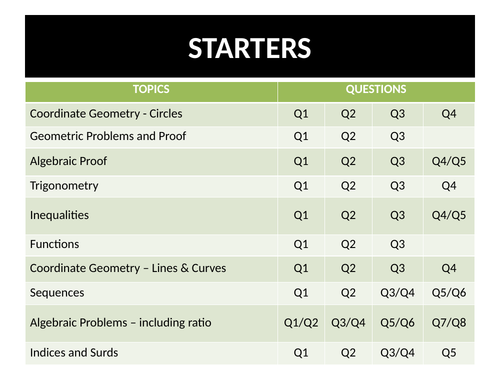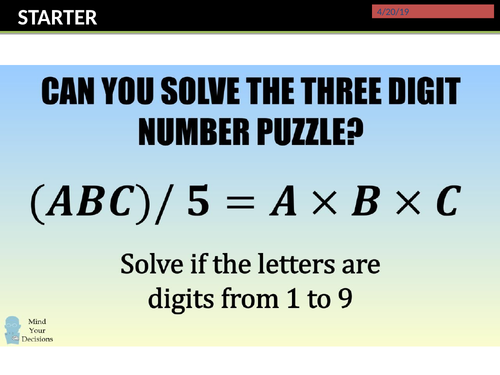
43Uploads
19k+Views
8k+Downloads
All resources

IB Maths Applications and Interpretation SL: Chapter 8 - Spearman's, Hypothesis Testing, Chi-Squared
This unit contains 5 Powerpoints:
Spearman’s rank
hypothesis testing - chi-squared test of independence
goodness of fit test
goodness of fit - normal and binomial distributions
t-test
Through the PowerPoint there are links to Youtube videos, GeoGebra and Desmos interactive. The PowerPoint has worked examples, and student exercises. I have also put in past paper exam questions for each topic.
I have also included an overall Statistics Test (2 parts short and long questions) and Chi-Squared test of Independence assignment, both with markschemes. As well as a review PowerPoint on the test of Independence. We sent a lot of time on this chapter as the idea was many students would use this for their IA’s, which they did.

IB Maths AI: Voronoi Diagrams
This complete lessons contains Desmos and GeoGebra interactives to demonstrate how to create voronoi diagrams, as well as examples. The lesson starts off with a review on finding equations of perpendicular bisectors then moves into a explorative task about voronoi diagrams. The lessons covers the following topics:
equation of a perpendicular bisector
how to construct a perpendicular bisector
key terminology used when constructing voronoi diagrams
how to construct a voronoi diagram with multiple sites
finidng centre of a circle using perpendicular bisectors of cords
finding locations of missing sites
nearest neighbour
adding new sites to a voronoi diagram
toxic waste dump problems (largest circle)
At the end this is a multiple choice quiz. There are also embedded link to Desmos Classroom activities. As well, throughout the PowerPoint there are worked examples and exercises and past paper exam questions for students to complete.

IB Maths Applications and Interpretation SL: Chapter 3 - Representing and Describing Data
This PowerPoint follows the Oxford textbook.
The following content is covered throughout the PowerPoint. I have also added a few extra concepts which can be used in students Internal Assessments (IA). For example, I spend a little time looking at the skewness formula, different ways of calculating outliers, 1.5 x IQR or 2 X SD, skewness in box plots, etc.
Univariate data
* qualitative vs quantitative
* continuous vs discrete
* which representations are used for specific types of data
* primary and secondary data
* choosing a good sample
* sampling bias
* reliability vs validity
* skewness
Questionnaires
* biased questions
Measures of central tendency
* mean, meadian, mode
* outliers
* un-grouped and grouped
* how to use the GDC
* combined mean
Measures of dispersion
* range, quartiles, IQR, standard deviation
* normal distribution curve
* skewness
* different formulas for sample and population for SD
* how to use the GDC
* effects on mean and SD
Sampling techniques
Presentation of data
Bivariate data
* scatter graphs
* correlation
* introduction into the line of best fit (leading into chapter 6)
Throughout the PowerPoint there are worked examples and student exercises. There are also multiple links to various classroom and interactive activities using GeoGebra and Desmos Classrooms. As well, I have included links to certain Youtube videos to help with using the GDC.

IB Maths Applications and Interpretation SL: Chapter 12 - Differential Calculus
This unit contains 2 Powerpoints:
Differentiation
Optimisation
Through the PowerPoint there are links to Youtube videos, GeoGebra and Desmos interactives. The PowerPoint has worked examples, and student exercises. I have also put in past paper exam questions for each topic.
I have also included a worksheet with solutions.

IB Maths Applications and Interpretation SL: Financial Mathematics
The following contains 4 PowerPoints covering the following topics:
Simple Interest
Compound Interest
Inflation
Depreciation
Loans
Annuities
Amortization
Each PowerPoint contains worked examples, student exercises and Past Exam questions. There are also links throughout to various YouTube explanations (eg. difference between simple interest and compound interest, what is amortization?, etc.), How to use the GDC examples, Desmos, and Geogebra interactives.

IB Maths Applications and Interpretation SL: Chapter 7 - Probability, Binomial/Normal Distributions
The following contains 5 PowerPoints:
Introduction to Probability
Venn Diagrams
Probability DIstributions
Normal DIstributions
Binomial DIstributions
Through the PowerPoint there are links to Youtube videos, GeoGebra and Desmos interactives. The PowerPoint has worked examples, and student exercises. I have also put in past paper exam questions for each topic.
I have also included a Normal Distibution Review PPT and assignment with markscheme.

IB Maths Applications and Interpretation: Chapter 1 - Measuring Space
This PowerPoint follows the entire content for Chapter 1 of the Oxford textbook. Certain topics included are not in chapter 1 but builds on the skills students are currently learning in the chapter and will be useful later on. For example, for the simplifying indices topic I go a little further into writing indices in non-fractional form which is useful for when you teach derivatives. Conent covered through the PowerPoint include:
Measurements and Estimates
Rounding and Significant Figures
Upper and Lower Bounds
Measurement Error
Percentage Error
Basic Exponent Rules
* changing bases
* writing in non-fractional form
Standard form (scientific notation)
Right angle trigonometry
* Pythagoras
* proving right angle triangles
* algebraic problems
* SOH-CAH-TOA
* elevation and depression
* problems involving circles
* 3D problems
* problems involving special quadrilaterals
* angles between lines and planes
Arc Length
Throughout the PowerPoint you will find GeoGebra links (click the icon) as well as Past Paper questions. There are also worked examples and exercises for students to complete throughout the lesson.

IB Maths Applications and Interpretation SL: Chapter 9 - Power Functions
There are 2 PowerPoints for this unit:
Quadratics and Cubics
Optimization without Calculus
PowerPoint 1 goes through:
-domain and range (recap)
-intercepts
-power functions
-3 forms of a quadratic
-axis of symmetry
-modeling
-finding equations of functions
-inverse functions (recap)
Through the PowerPoint there are links to Youtube videos, GeoGebra and Desmos interactives. The PowerPoints have worked examples, and student exercises. I have also put in past paper exam questions for each topic.

IB Maths Applications and Interpretation SL: Chapter 11 - Trigonometric Functions
This unit contains a Powerpoint which goes through the following:
-periodic functions
-sine, cosine, and tangent curves
-transformations of sinusoidal functions
-sketching
-finding equations
-modeling questions
Through the PowerPoint there are links to Youtube videos, GeoGebra and Desmos interactives. The PowerPoint has worked examples, and student exercises. I have also put in past paper exam questions for each topic.

IB Maths Applications and Interpretation SL: Chapter 4 - Dividing Up Space
The PowerPoint follows chapter 4 from the Oxford textbook. There are worked examples, student exercises and past paper exam questions for each section. I have also embedded links to various Youtube, GeoGebra and Desmos activities and visuals to help improve student understanding. The PowerPoint contains the following content:
recap piecewise functions
the number plane
distance between 2 points (2D & 3D)
midpoint (2D & 3D)
classifying triangles given coordinates
coordinate geometry in 3D space
gradients
different forms of an equation of a line
points of intersection
parallel and perpendicular lines
collinear points
perpendicular bisectors
shortest distance to a line

IB Maths Applications and Interpretation SL: Optimisation
The following lesson goes through the following:
-Optimisation without calculus
-The second derivative
-Optimisation with calculus
The lesson contains worked examples along with IB practice problems.

IB analysis and approaches SL - Chapter 1 - Sequences and Series
This PowerPoint follows the entire content for Chapter 1 of the Oxford textbook. PowerPoints have worked examples as well as extra practice questions for students to do in class. I have pulled together questions and examples from various resources. Each PowerPoint as contains past IB exam questions for students to get familiar with the style of questioning. Content covered through the PowerPoints include:
arithmetic sequences and series
geometric sequences and series
sigma notation
compound interest
binomial theorem
proofs

IB Maths Applications and Interpretation SL: Chapter 6 - Modelling Relationships
The following PowerPoint covers Chapter 6 from the Oxford textbook. Modelling Relationships: Linear Correlation and Bivariate Data. The Lesson contains various interactive activities such as Desmos Classroom for review exercises, Geogebra and Phet Simulations for showing line of best fit, least-squares, etc. There are also video links on how to used the GDC to find correlation and linear regression. The PowerPoint covers the following content below.
correlation review (from chapter 3)
finding correlation coefficient (PMCC)
discussion about covariance
interpreting PMCC
correlation and causation
coefficient of determination
line of best fit
interpolation and extrapolation
reliability
linear regression
residuals
piecewise functions
* step functions
All my PowerPoints have worked examples and exercises for students to complete. I have also added past paper questions in each section to get students accustom to the type and style of questions they will see on their exam. This PowerPower in particular comes with a Microsoft Teams quiz on Correlation and Linear Regression.

IB Maths Applications and Interpretation SL: Chapter 2 - Representing Space
The PowerPoint covers the complete content of Chapter 2 of the Oxford textbook. I have also added a few extension topics which build upon what students are learning and will be useful further in the course. Topics cover in the PowerPoint include:
The sine law
* the ambiguous case
The cosine law
Area of non-right angle triangles
Algebraic triangle problems
3D Problems involving non-right angle triangles
Area of sectors
Area of Segments
3D shapes
* surface area
* volume
* writing expressions
* algebraic problems
* capacity
There are also Past Paper questions embedded into the lesson along with various GeoGebra and Desmos interactive activities.

IB Maths: Applications and Interpretation SL - Exponential and Logarithmic Functions
Complete PowerPoints for Chapter 10 - Modelling Rates of Change: Exponential and Logarithmic Functions, for the Oxford textbook. The PowerPowers can be used with other textbooks. PowerPoints are built around students learning the the following topics online, but can also be used to deliver in-class. PowerPoints have embedded links to video examples, Desmos activities, GeoGebra, and Casio GDC videos. The following is the topics that the 8 PowerPoints cover.
Geometric Sequences
Geometric Series
Compound Interest
Annuities
Amortization
Exponential Functions
Exponential Models
Exponential & Logarithmic Equations
There are also Past Paper questions in each section of the unit.

IB Maths Applications and Interpretation SL: Chapter 13 - Integration
This unit contains 2 Powerpoints:
Integration
Trapezium Rule
Through the PowerPoint there are links to Youtube videos, GeoGebra and Desmos interactives. The PowerPoint has worked examples, and student exercises. I have also put in past paper exam questions for each topic.

GCSE 9-1 Maths Higher Level Starters (Target 8-9)
The following starter questions are for students targeting grades 7-9. Questions are taken from various exam boards and include solutions. Encourages students to think and apply their skills in different contexts. Entire PowerPoint includes over 50 questions in the following categories:
Coordinate Geometry - Circles
Geometric Problems and Proof
Algebraic Proof
Trigonometry
Inequalities
Functions
Coordinate Geometry – Lines & Curves
Sequences
Algebraic Problems – including ratio
Indices and Surds
Statistics
Extra

Time Series Assignment
Here is a short independent task looking at time series of population over time. It also creates discussion for curves of best fit.

IB Maths Analysis and Approaches SL: Quadratic Inequalities
I used this lesson before going into the quadratic formula and the discriminant.

GCSE 9-1 Maths Digit Proofs
For those higher achieving students looking to get a grade 9. As proofs is new to the Edexcel specification, digit proofs is not common but has shown up on a Mock Exam.




















